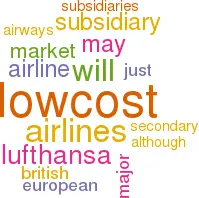All Go for European low-cost subsidiaries?
March 1998


Europe’s major airlines are watching with interest British Airways' plans for Go, its low–cost subsidiary. Could 1998 be the year when Europe’s major airlines launch their own low–cost subsidiaries en masse, or will BA’s competitors decide to keep out of the low–cost market for the time being?
The phenomenon of major airlines starting a low–cost subsidiary has been around in North America for several years, with mixed results. Continental Lite failed miserably, but Delta Express and United Shuttle do seem to be succeeding (although part of their success may be to do with the non–allocation of the parent’s overhead cost — something that will be scrutinised at Go). US Airways has now revealed its plans for its low–cost subsidiary, MetroJet, to launched in June. The low–cost airline will be based in Baltimore and initially it will serve just four destinations, using a fleet of five 737–200s.
In the US the key (and often the stumbling block) to low–cost subsidiaries is an agreement with the labour unions. In Europe the power of unions is, if anything, greater. In addition, an impediment to low–cost airlines is how to gain cheap slots at secondary airports.
Although slots are plentiful, as British Midland’s Austin Reid has pointed out (see page 15) it is becoming difficult to win very cheap deals at secondary airports. Lufthansa is the latest European major to study the feasibility of a low cost subsidiary. Lufthansa Light would operate between European secondary city pairs, although initially the airline would just operate in Germany. Lufthansa needs further time before it will make a final decision on the idea, and the airline may wait until there are lessons to be learnt from Go.
The impetus behind Lufthansa’s move is clear — the losses it racks up flying domestically. Without a low–cost operation of its own, there is little prospect that Lufthansa can turn a profit within Germany, particularly when it continues to reduce fares on routes where it faces competition from Deutsche BA (see Aviation Strategy, November 1997).
A much greater challenge may be posed by distribution. Unlike the British, Germans are not used to paying for goods and services over a telephone with a credit card. If Lufthansa is to encourage the domestic market to change its shopping habits, a re–education campaign will be needed, which will be costly. The US experience has shown than direct booking are essential to the success of a low–cost airline. Margins are tight, and if Lufthansa Light has to rely on traditional means of seat booking, the airline may not prove to be feasible economically.
Establishing a low–cost subsidiary will therefore not be easy for Lufthansa, and other European airlines may come to the same conclusion. But just because it is difficult to achieve should not mean that airlines should not attempt it. The culture at head office is all–important here.
Timeframe is another important consideration. Jan Stenberg, president of SAS, claims that the airline has seen only a marginal impact from existing low–cost airlines, such as Ryanair on London Luton- Stockholm. But an airline’s strategic rationale cannot be determined just by the current market situation.
What British Airways is trying to do is establish a market position for the future. Other airlines are less far–sighted. That does not mean they have made a mistake — Go and the concept of the low–cost subsidiary may not prove successful — but that they are essentially adopting a passive market strategy.